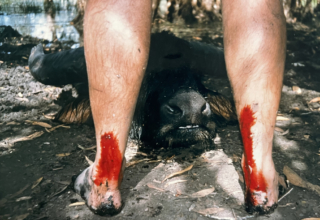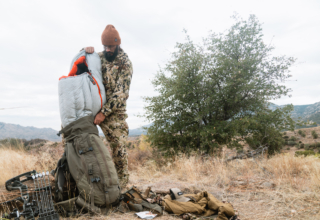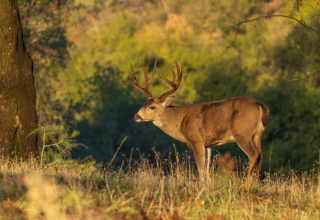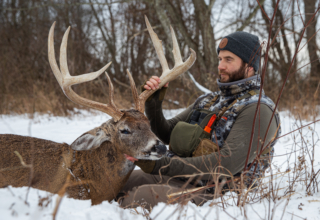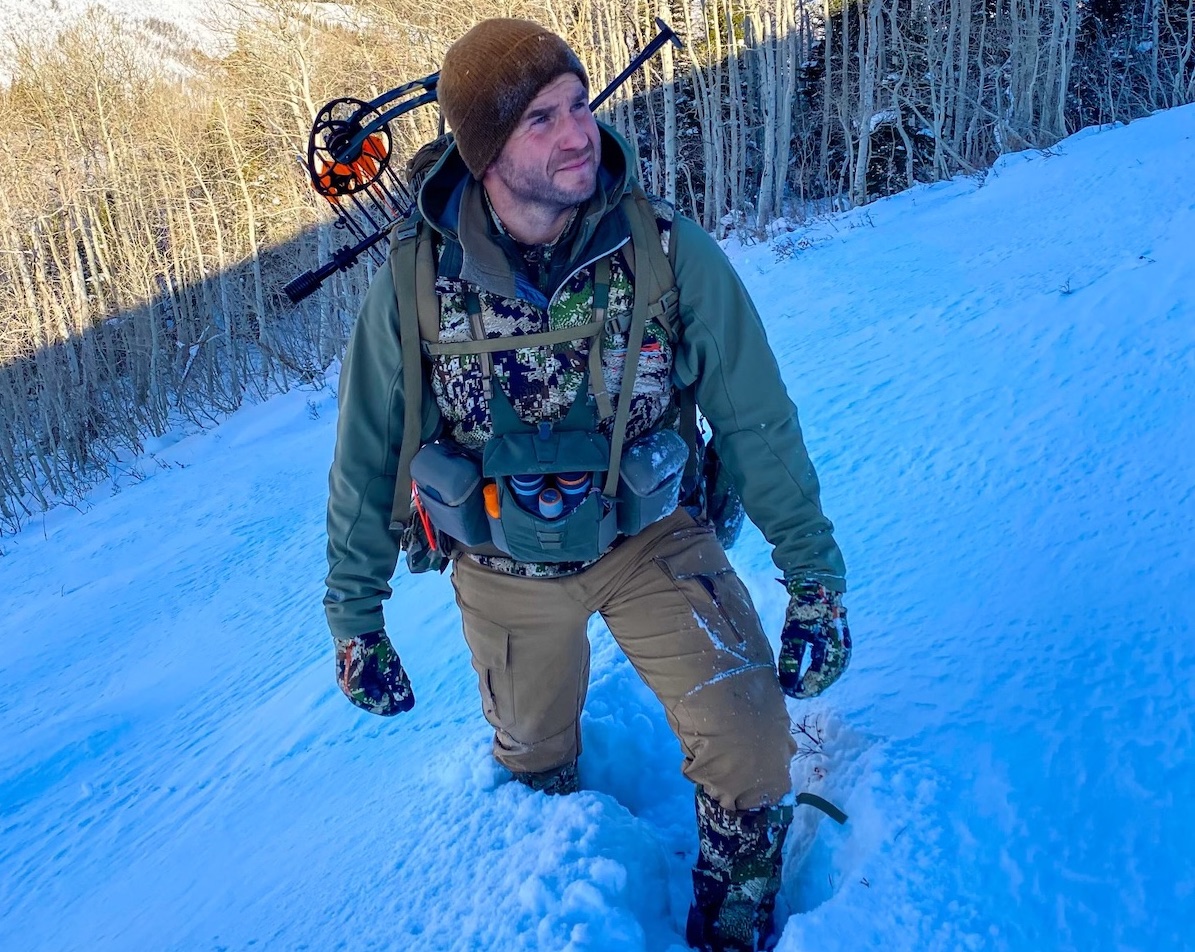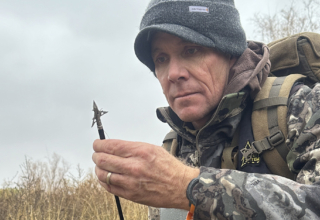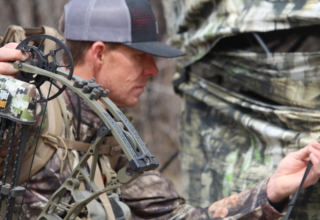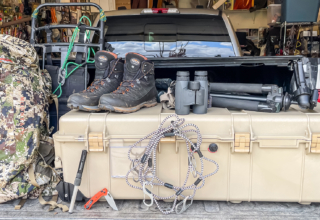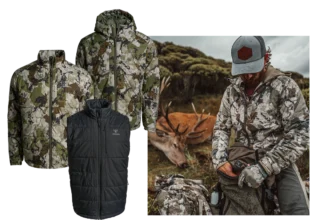If you’ve been tinkering with becoming a backcountry nomad and wandering the Rockies in search of mule deer nirvana, the to-come A to Z information will put you on the fast track to mule deer success.
by Clint Casper
You’ve decided you want to embark on a high country mule deer bowhunt. That’s fantastic news because this style of adventure bowhunting is some of the most exciting yet demanding hunting a person can do. Knowing your mental and physical capabilities and being hyper-focused on being comfortable with your gear is an absolute must.
I’m not here to romanticize these bowhunts. Instead, I’m here to prepare you for an extreme bowhunting adventure and challenge. On a bowhunt like this, our main plan will be to pack into the high country, set up our camp and use our glass from vantage points to spot bucks in the basins they call home. From there, we will formulate a plan of attack via a stalk and hopefully put an arrow through the pump house of one of these grey ghosts that roam the mountains.
Let’s break this hunt down into four main components.

Physical Prep
When it comes to the high country, early season, mule deer, and the thought of bowhunting them, the first image that pops into my head is steep, rugged terrain. If you hope to find high-country locales filled with beautiful, hidden, neon-green basins, you must first get to them. This requires much physical and mental work long before the bowhunt starts. Packing in a full 50-60 pound pack to your base camp for an extended stay is expected, and then packing your hard-earned trophy out at the end will also require heavy loads.
You need to ask yourself two questions before you begin the prep work: What do I need to do on this hunt to succeed, and what type of training will mimic what I’m about to do on this hunt?
I immediately think about backpacking for an extended period, which entails a heavy pack, while walking many steep miles. To conquer this type of physical demand, my workouts consist of cardio, core body movements, back and leg workouts, and extended heavy-pack hikes at the end of each workout.
I’m trying to prepare my body to be comfortable during uncomfortable times. Heavy packs and long miles are the norms on a hunt like this, so my back, legs, core, and heart/lungs are must-train areas. Unfortunately, curls for the girls will NOT do much for you on the mountain while chasing mule deer. They don’t seem to care how big your biceps are.

Exercises like leg curls, squats, deadlifts, back rows, seated rows, push-ups, sits ups, and body weight squats are all excellent movements to do for this type of hunt. As far as cardio goes, I do not run. Why? Because on this extreme-terrain hunt, I don’t run to cover ground but instead hike with a heavy pack. I train for this using a treadmill set at incline with 60 to 70 pounds in my pack. This mimics what I’ll experience in the backcountry when hunting mule deer
Mental Prep
On a hunt like this, mental preparation is critical and may be the most essential category I write about in this article. What I mean by that is with a hunt like this comes many unknowns, bumps, bruises, and failed plans. Mishaps and pain are just part of the game. To not lose positivity and mental toughness, one must be prepared for things to fail.
One thing I’ve always leaned on during hunts like these is my ability to be like Gumby. Gumby is flexible; Gumby can change shape and size. Gumby also figured out ways to get out of a nasty pinch. We want to be like Gumby! Knowing that plans will fail, stalks will fail, spots will fail, WE will fail, etc., can prepare us to be ready to be Gumby and use flexibility and positivity to our benefit.

Being mentally ready for challenging hikes, long days, longer nights, failed plans, and unknown obstacles prepares us for the dogfight these bowhunts bring.
I’m not here to sugarcoat things. At points during these hunts, you will want to give up, go home, quit, etc., but you have to take the punch to the teeth and get back up and keep fighting. That mentality will get you a hard-earned opportunity and keep YOU in the game.
Comfortable Being Uncomfortable
Sleep is a staple on adventure-style bowhunts, and if you’re not getting good sleep, even if it’s only a few hours each night, your body will not let you do what you need to do. We must feel safe and secure about a good night’s sleep, so let’s first talk about our shelter.

On a hunt like this, I want to go in light and come out heavy. Everything I use on an early-season high country bowhunt is decided upon with ounces in mind. I like a lightweight, one- or two-person tent with a floor for an early-season shelter. The Big Agnes Tiger Wall and the Flycreek Ultralight 2 are practical options that fit these descriptions. I’ve used both for years and love them. They’re super durable and extremely lightweight. They also have extra vestibules for your gear to stay dry and out of the elements. My pack, bow, boots, and water bladders usually go in the vestibules. These tents pack up super small and go up super quickly.
Another great option I’ve run over the years is tipi tent-style shelters with or without a stove. The Kifaru Sawtooth and the Seek Outside Cimarron are two tipi-style tents I’d highly recommend. These shelters have no floor and utilize a tipi-style framework system, making these tents ultra-durable in just about any weather scenario.
Both of these weigh under six pounds with a stove, which is very reasonable and lightweight for this shelter style. A great reason to run one of these shelters would be bowhunts in mid- to late-September, when inclement weather, like snow, could arise.
The collapsible stove is a must-have item on hunts like these, and I can tell you from experience there’s nothing better than an excellent warm tipi after a long day of bowhunting. Comfort equals good sleep!
Speaking of sleep, let’s jump into finding a sleep system. My sleep system has three main parts: my sleeping pad, sleeping bag, and pillow. I want a packable, lightweight design for a sleeping pad with an “R” rating high enough to keep the frost out. This rating tells you how much insulation you’ll have between you and the ground, so the higher the number, the more insulation you’ll have, usually ranging from 1-5. I use a Big Agnes Q Core SLX sleeping pad; it’s a 4 rating. This pad is a three-season pad, meaning it’s good all through the fall when I’m on most of my bowhunts. It’s lightweight, weighing 15 ounces and measuring 4.5 inches thick when blown up.
I highly recommend this pad

I have multiple bags for different weather conditions, but my go-to bag for an early-season hunt like this is my Sitka Kelvin Aerolite 30. This bag has a zippered bottom and arm pockets, so you can open the bottom and put your feet out, or even walk around with it on. The zippered arm slots allow me to roll with the bag as I sleep. I’m a mover while sleeping, so the arm zipper openings are a great addition that most bags don’t have.
This bag is rated to 30 degrees at a comfortable level and 20 degrees at the lowest level, which is plenty for an early-season high country bowhunt. Do NOT SKIMP ON A SLEEPING BAG! I’ve been here before; I slept like crap and had a miserable hunt because I didn’t want to spend the extra two hundred dollars for a good bag.
As far as a pillow goes, I’ve used two options, one being my puffy jacket as my pillow. This is a good option until temps dip, and you need to wear your puffy jacket in your bag. A better option is a lightweight pillow, like my favorite, the Sea To Summit Aeros down pillow, weighing in under 4 ounces. I sleep like a dream with this pillow, as it reminds me of the comforts of home while in the backcountry.
Packs, Boots, and Clothing
One of the very most important pieces to this bowhunting style will be your pack. Your pack is your lifeline and needs to be durable, comfortable, lightweight, and functional. For myself, the only packs I run currently, and for a good reason, are those from Kifaru. These packs are built with durability and longevity in mind but still have a lightweight design.
I have run just about every pack brand out there, and Kifaru checks all the boxes for me. I use their Ultralite Duplex frame with a couple of different bags, depending on my style of bowhunt. For a mule deer hunt, I run the .44 Mag bag a lot; a 4000-plus cubic inch bag. This bag has a meat shelf for hauling heavy loads and a ton of pockets and molle webbing to attach other pouches. I can easily pack enough for 8-10 days out of this bag, and its sleek design, when folded up, make it an excellent choice for a hunt like this.
Boots are something that, at times, is highly overlooked and an item that people will want to skimp on. Don’t be this person! If you do not have good boots, your feet, hips, back, and mental and physical health will all suffer, and your hunt will quickly turn into a miserable experience.
I have a 50-mile rule, which means I put 50 miles on a new pair of boots before taking them on any hunt. This allows my feet to get used to the boots and the boots to get broken in well before I start scaling mountains in search of mule deer.
My favorite brand of boots is Crispi. Crispi is an Italian-based boot company with a ton of options to choose from. On a hunt like this, I want a stiff, lightweight Gore-Tex boot with good ankle support. Currently, two of my favorites are the Thor and Lapponias. Both are under a pound and a half per boot and feature a stiff sole, excellent ankle support for those steep uphill and downhill climbs, and Gore-Tex to keep my feet dry.
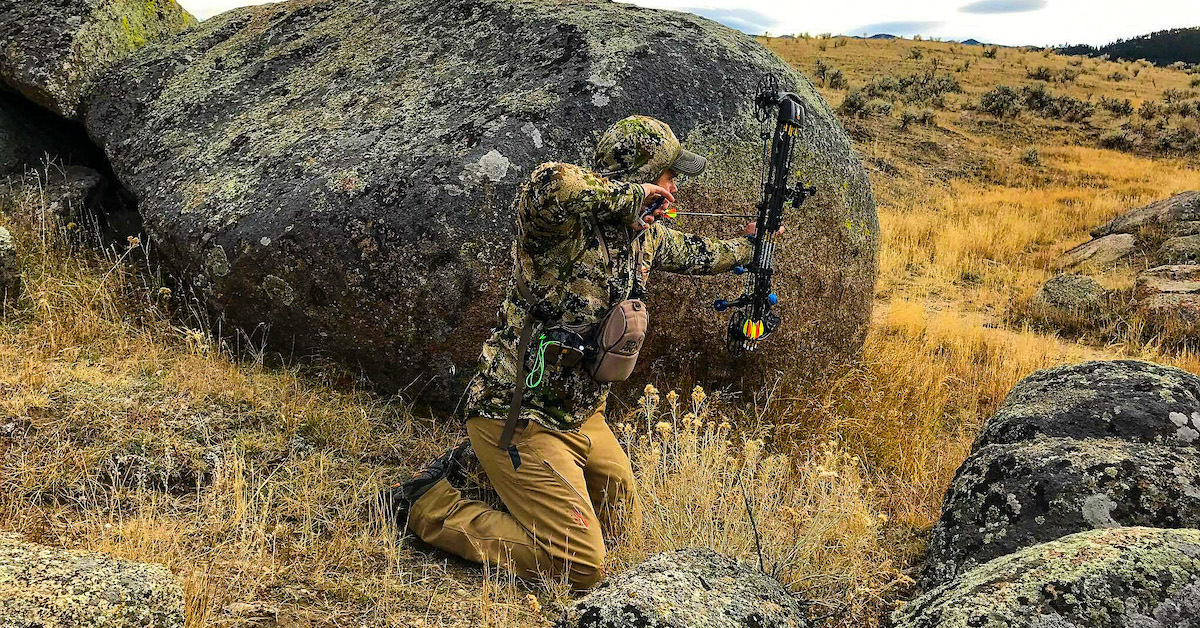
When it comes to clothing on an adventure bowhunt like this, I cannot stress enough the importance of an excellent system to face the elements. I run a combination of Sitka Gear and Black Ovis products. I have a specific system that allows for the changing weather patterns.
First, I use three pairs of Black Ovis or Sitka boxers. I wear one pair in and take two extras. I do the same for socks and use Darn Tough Merino wool, midweight socks, or Black Ovis midweight tech socks. Rain gear is a must, and I only use Sitka’s Dewpoint pants and jacket, as they are as lightweight, breathable, and durable as I’ve found. I use the Sitka Mountain or Black Ovis Granite Peak pants. Both are quick-drying, durable, and lightweight, with ample pockets.
For base layers, I run only Sitka Gear tops and bottoms. Next is a puffy jacket, which is invaluable on a hunt like this because it’s used as a glassing pad, a puffy, and sometimes a pillow. My favorite is the Sitka Kelvin Lite. For a mid-layer, I like a midweight core zip from either Sitka or Black Ovis. I’m a big believer in vests, which break the wind and add comfort for extended hunts. Sitka makes a few great options, including the Mountain and Aerolite. Both add warmth and cut the wind great.
I also take two pairs of gloves and a good stocking cap for cold mornings and evenings. Your clothing must work together as a system to succeed on a hunt like this. It’s not reasonable to take 15 clothing items on a hunt like this, adding a ton of weight to an already heavy pack.
Glass! Safety First! Technical Gear!
You cannot kill what you cannot see, so your glassing tools are essential. I use a Sirui T 024SK carbon tripod with their VA-5 fluid head. This is a super sturdy, lightweight tripod that I’ve had great success with. I am running the new Kifaru Bino Harness for a bino harness. My spotting scope is Leupold’s SX-5 Santiam HD 27-55×80, and the glass I put in my bino harness is Leupold’s 12×50 BX-5 Santiam HD binoculars. This system allows me to scan for bucks with the binoculars quickly and then switch over to the spotting scope and tripod to hone in on them. I’ll use my puffy jacket or pillow as a glassing pad to keep my rear end comfortable on long glassing stands. Good glass keeps your eyes in the game and keeps you on the hunt!

For safety precautions in the backcountry, I have two main items. The first is my first aid kit. I built the first aid kit that I keep in a Kifaru orange-colored pull-out. Inside the kit is Tylenol, Benadryl, Derma-bond glue, Adventure Medical Quick Clot, Band-Aids, Butterfly bandages, Alcohol pads, Leuko tape, and wet wipes.
My other piece of Emergency equipment is my Garmin Mini Inreach. This device syncs and stays connected to my phone to allow me to communicate with the outside world. It also has an SOS button, which can be pushed in moments of actual emergency. This alerts nearby services of your location and gets help coming your way. Although I have never used this button, I almost did in Colorado a few years back and was extremely happy I had that option if needed. Our goal is ALWAYS to make it home safe. Don’t skimp on these items.
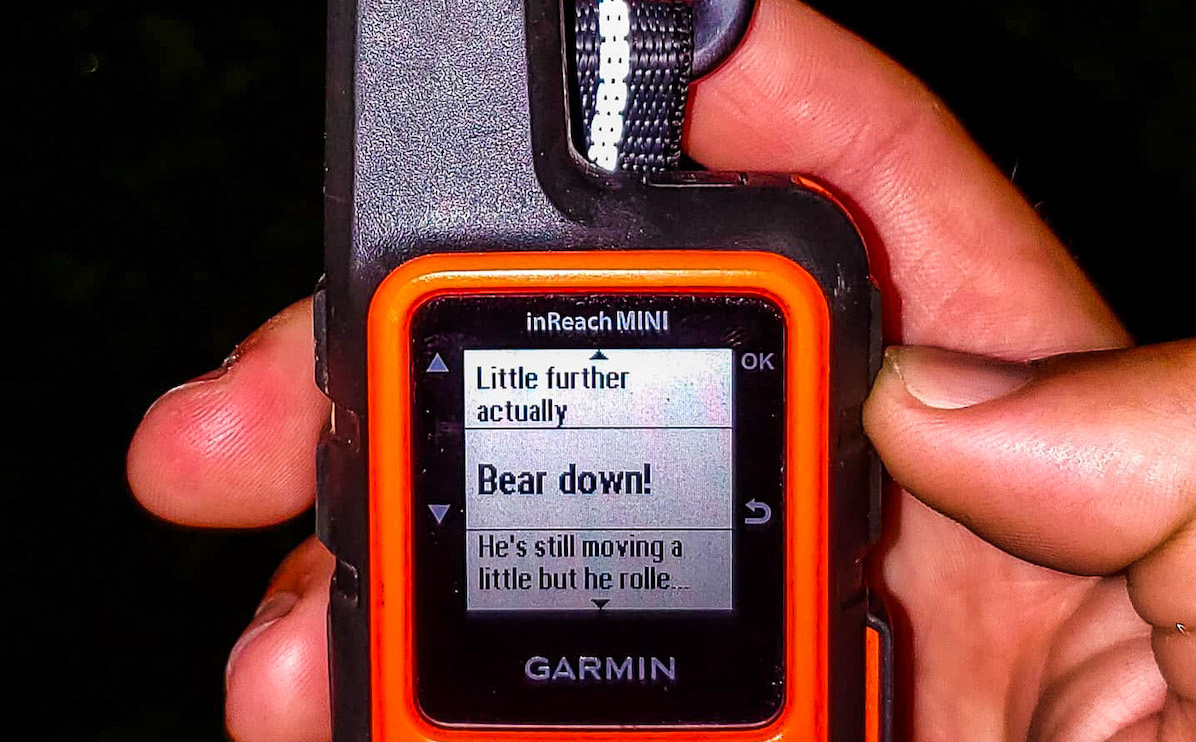
Regarding some technical gear that I recommend, my stove is an Optimus Crux Lite, which is super lightweight and has a wind-blocking backer. Peax Equipment makes trekking poles and they’re called Sissy Sticks and have proven to be as durable as they come. I highly recommend a watch to track miles, heart rate, altitude, etc. I run a Garmin Instinct Tactical Solar. It links with my phone and inReach, so it’s all connected into one spot on my phone app via Garmin. This watch is handy in the backcountry and has a GPS. For navigation, I download and use onX maps. I can’t say enough about how well onX makes mapping in the backcountry for making attack plans, and you can download maps offline ahead of time.

This style of bowhunting mule deer creates the best adventures a person can have. With some hard work, willpower, and a never give up attitude, YOU can find success and enjoy the process of these bowhunts. You only live once, don’t wait. Plan that high-country hunt and start prepping NOW!


